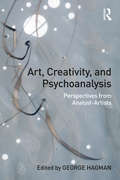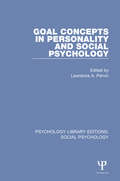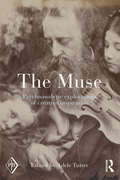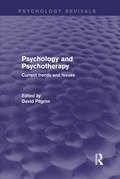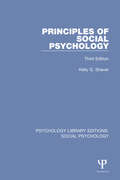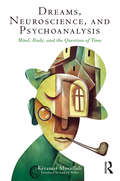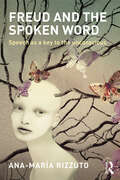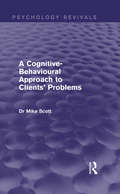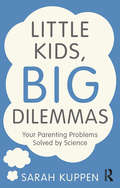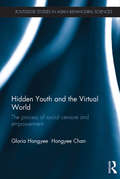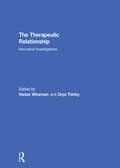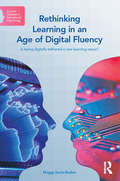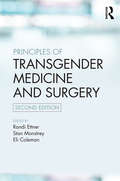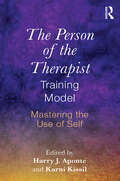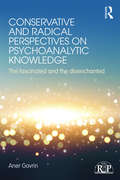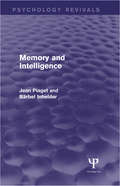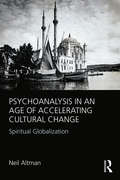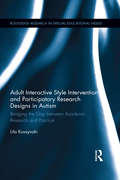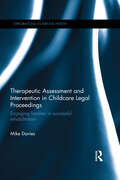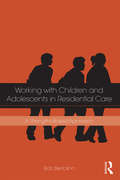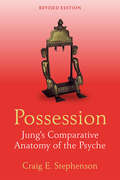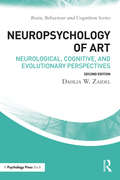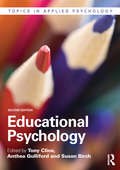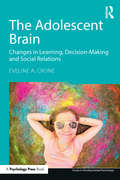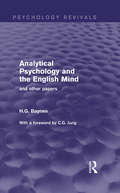- Table View
- List View
Art, Creativity, and Psychoanalysis: Perspectives from Analyst-Artists
by George HagmanArt, Creativity, and Psychoanalysis: Perspectives from Analyst-Artists collects personal reflections by therapists who are also professional artists. It explores the relationship between art and analysis through accounts by practitioners who identify themselves as dual-profession artists and analysts. The book illustrates the numerous areas where analysis and art share common characteristics using first-hand, in-depth accounts. These vivid reports from the frontier of art and psychoanalysis shed light on the day-to-day struggle to succeed at both of these demanding professions. From the beginning of psychoanalysis, many have made comparisons between analysis and art. Recently there has been increasing interest in the relationship between artistic and psychotherapeutic practices. Most important, both professions are viewed as highly creative with spontaneity, improvisation and aesthetic experience seeming to be common to each. However, differences have also been recognized, especially regarding the differing goals of each profession: art leading to the creation of an art work, and psychoanalysis resulting in the increased welfare and happiness of the patient. These issues are addressed head-on in Art, Creativity, and Psychoanalysis: Perspectives from Analyst-Artists. The chapters consist of personal essays by analyst/artists who are currently working in both professions; each has been trained in and is currently practicing psychoanalysis or psychoanalytic psychotherapy. The goal of the book is to provide the audience with a new understanding of psychoanalytic and psychotherapeutic processes from the perspective of art and artistic creativity. Drawing on artistic material from painting, poetry, photography, music and literature, the book casts light on what the creative processes in art can add to the psychoanalytic endeavor, and vice versa. Art, Creativity, and Psychoanalysis: Perspectives from Analyst-Artists will appeal to psychoanalysts and psychoanalytic psychotherapists, theorists of art, academic artists, and anyone interested in the psychology of art.
Goal Concepts in Personality and Social Psychology (Psychology Library Editions: Social Psychology)
by Lawrence A. PervinIs behavior motivated? And if so, can it be motivated by the anticipation of future events? What role does cognition play in such motivational processes? And, further, what role does motivation play in ongoing cognitive activity? Questions such as these provide the foundation for this book, originally published in 1989. More specifically, the chapters in this book address the question of the utility of goals concepts in studying motivation and social cognition.
The Muse: Psychoanalytic Explorations of Creative Inspiration (Psychoanalytic Inquiry Book Series)
by Adele TutterPsychoanalysts have long been fascinated with creative artists, but have paid far less attention to the men and women who motivate, stimulate, and captivate them. The Muse counters this trend with nine original contributions from distinguished psychoanalysts, art historians, and literary scholars—one for each of the nine muses of classical mythology—that explore the muses of disparate artists, from Nicholas Poussin to Alison Bechdel. The Muse breaks new ground, pushing the traditional conceptualization of muses by considering the roles of spouse, friend, rival, patron, therapist—even a late psychoanalytic theorist—in facilitating creativity. Moreover, they do so not only by providing inspiration, but also by offering the artist needed material and emotional support; tolerating competitive aggression; promoting reflection and insight; and eliciting awe, anxiety and gratitude. Integrating art history and literary criticism with a wide spectrum of contemporary psychoanalytic perspectives, The Muse is essential reading for psychoanalysts and psychotherapists interested in the relationships that enhance and support creative work. Fully interdisciplinary, it is also accessible to readers in the fields of art, art history, literature, memoir, and film. The Muse sheds new light on that most mysterious dyad, the artist and muse—and thus on the creative process itself.
Psychology and Psychotherapy: Current Trends and Issues (Psychology Revivals)
by David PilgrimOriginally published in 1983, fifteen well-known psychologists and psychotherapists write about their personal interests to give the reader a vivid picture of the complexities of psychotherapy in Britain at the time. They explore aspects of the interaction and intersection of the psychological and psychotherapeutic worlds, paying particular attention to the practical and theoretical controversies involved in this overlap. The first half of the book concerns itself with problems of theory and practice in psychology and psychotherapy, while the second half deals with professional conflicts and political issues impinging upon the practice of psychotherapy by psychologists. Areas of concern and controversy that are scrutinised include the problematic relationship between academic psychology and psychotherapy; doubts and certainties in psychotherapy; the psychology of helping; the relevance of the psychodynamic tradition; inter-professional disputes; women and psychotherapy; and social class issues in psychotherapy.
Principles of Social Psychology: Third Edition (Psychology Library Editions: Social Psychology)
by Kelly G. ShaverOriginally published in 1987 this third edition won praise from students and instructors alike for its challenging "no nonsense" approach to the field. Thoroughly updated to reflect current research of the time, the text retains the qualities that had become its hallmarks: a cognitive approach to the process of socialization, and an emphasis on the ideas that give the discipline continuity. It offers clear, conceptually integrated discussions of all of the major topics in social psychology from the time. Shaver's focus on the concepts of social psychology provides a framework for students to develop their own applications. The principles of social behavior are presented in the text in the same way they develop in the individual moving from internal processes (social perception, self-recognition) to external issues (the environment, the law) that influence behavior. Shaver weaves contemporary issues into his treatment of basic theories, using examples from everyday situations. His supple writing engages students in the complexity of social behavior, and is one reason this title remained one of the most highly regarded texts in the field at the time.
Dreams, Neuroscience, and Psychoanalysis: Mind, Body, and the Question of Time
by Keramat MovallaliDreams, Neuroscience, and Psychoanalysis sets out to give a scientific consistency to the question of time and find out how time determines brain functioning. Neurological investigations into dreams and sleep since the mid-20th century have challenged our scientific conception of living beings. On this basis, Kéramat Movallali reviews the foundations of modern neurophysiology in the light of other trends in this field that have been neglected by the cognitive sciences, trends that seem to be increasingly confirmed by recent research. ? The author begins by giving a historical view of fundamental questions such as the nature of the living being according to discoveries in ethology as well as in other research, especially that which is based on the theory of the reflex. It becomes clear in the process that these findings are consistent with the question of time as it has been considered in some major contemporary philosophies. This is then extended to the domain of dreams and sleep, as phenomena that are said to be elucidated by the question of time.? The question is then raised: can dreaming be considered as a drive? Based on the Freudian discovery of the unconscious and Lacan’s teachings, Movallali seeks to provide a better understanding of the drives in general and dreams in particular. He explores neuroscience in terms of its development as well as its discoveries in the function of dreaming as an altered mode of consciousness. The challenge of confronting psychoanalysis with neuroscience forces us to go beyond their division and opposition. Psychoanalysis cannot overlook what has now become a worldwide scientific approach. Neuroscience, just like the cognitive sciences, will be further advanced by acknowledging the desiring dimension of humanity, which is at the very heart of its being as essentially related to the question of time. It is precisely this dimension that is at the core of psychoanalytic practice.? Dreams, Neuroscience, and Psychoanalysis will appeal to psychoanalysts and psychoanalytic psychotherapists as well as neuroscientists, psychologists, ethologists, philosophers and advanced students studying across these fields.
Freud and the Spoken Word: Speech as a key to the unconscious
by Ana-Maria RizzutoThere is extensive literature on Freud and language; however, there is very little that looks at Freud’s use of the spoken word. In Freud and the Spoken Word: Speech as a key to the unconscious, Ana-María Rizzuto contends that Freud’s focus on the intrapsychic function and meaning of patients’ words allowed him to use the new psychoanalytic method of talking to gain access to unconscious psychic life. In creating the first ‘talking therapy’, Freud began a movement that still underpins how psychoanalysts understand and use the spoken word in clinical treatment and advance psychoanalytic theory. With careful and critical reference to Freud’s own work, this book draws out conclusions on the nature of verbal exchanges between analyst and patient. Ana- María Rizzuto begins with a close look at Freud’s early monograph On Aphasia, suggesting that Freud was motivated by his need to understand the disturbed speech phenomena observed in three of the patients described in Studies on Hysteria. She then turns to an examination of how Freud integrated the spoken word into his theories as well as how he actually talked with his patients, looking again at the Studies in Hysteria and continuing with the Dora case, the Rat Man and the Wolf Man. In these chapters, the author interprets how Freud’s report of his own words shed light on the varying relationships he had with his patients, when and how he was able to follow his own recommendations for treatment and when another factor (therapeutic zeal, or the wish to prove a theory) appeared to interfere in communication between the two parties in the analysis. Freud and the Spoken Word examines Freud’s work with a critical eye. The book explores his contribution in relation to the spoken word, enhances its significance, and challenges its shortcomings. It is written for psychoanalysts, psychotherapists, Freud’s scholars and academics interested in his views on the words spoken in life and in psychoanalysis. Argentine born Ana-María Rizzuto trained in psychoanalysis in Boston and was for forty years in the PINE Psychoanalytic Center Faculty and is Training and Supervisory Analyst Emerita. She has made significant contributions to the psychoanalysis of religious experience and has written in national and international journals about the significance of words in the clinical situation. She has written three books and lectured about her work in North America, Latin America, Europe, and Japan.
A Cognitive-Behavioural Approach to Clients' Problems (Psychology Revivals)
by Michael J. ScottThe most useful therapy is one that can be applied to a wide range of client problems, is easy to learn, and produces lasting results following a brief intervention. The cognitive-behavioural approaches described in this volume probably come nearest to this ideal. Originally published in 1989, this book begins with a description of the cognitive-behavioural revolution that had taken place in the decade prior to publication and provides therapists with the specifics of helping in four major areas: child behaviour problems, emotional disorders (depression and anxiety), interpersonal problems and addictive disorders. Coverage of the major areas of concern begins in each case with an overview of theory and research in the specific domain, followed by detailed guidance for practice. The volume represents a synthesis of the author’s research and practice with patients in inner city Liverpool and with employees referred by major employers. The strategies described have been devised to take account of a wide variety of client social contexts and service delivery settings, and the strengths, pitfalls and practicalities of group cognitive-behavioural approaches are also discussed. The reader is finally led into largely uncharted waters, the application of cognitive-behavioural approaches to schizophrenia, people with learning difficulties and the elderly. Back in print, this title will still be of interest to students and practitioners in social work, clinical psychology, and community psychiatry.
Little Kids, Big Dilemmas: Your parenting problems solved by science
by Sarah KuppenFed up with conflicting advice? This book offers real answers to the following questions and more… Can sleep training harm my baby? Is screen time bad for my child? Is breast always best? Psychologist Dr Sarah Kuppen, expert in early child development, uses her scientific expertise to sort through the hype and give you the facts. Using the latest developmental research, she provides practical tips and solves more than 50 familiar parent questions and dilemmas. Inside you will find advice on: • five ways to tame a tantrum • what to do if your child isn’t talking • the scientific facts on breast versus formula feeding • managing sibling fights and conflict. Little Kids, Big Dilemmas is an essential guide for science-minded parents and childcare professionals alike. Reading this book will allow you to make informed decisions on the big topics for parenting in the early years.
Hidden Youth and the Virtual World: The process of social censure and empowerment (Routledge Studies in Asian Behavioural Sciences)
by Gloria Hongyee ChanHidden Youth and the Virtual World examines the phenomenon of ‘hidden youth’ or hikikomori, as it is better known in Japan as well as Hong Kong. Exposure to the Internet has allowed these young persons to develop a high level of capability within the virtual world, however these are skills that are not highly valued by society. This book uncovers the truth about hidden youth, the causes, coping strategies, power relations between them and adults in society, and their relationship with the virtual world. Key topics surrounding the phenomenon of hidden youth are explored in detail, including: The framework of Social Censure Theory The theoretical concepts of hegemony and the impact that labelling by the Government, the media and institutions has had on hidden youth The willingness of the hidden youth to remain hidden within the virtual world Subcultures as a platform for hidden youth empowerment This is a particularly useful volume to researchers in child and adolescent psychology, clinical psychology, counselling and psychotherapy, school psychology, sociology, social work, and youth policy; as well as youth workers, school counsellors and mental health professionals, and will appeal to the interest of both academics and practitioners alike.
The Therapeutic Relationship: Innovative Investigations
by Hadas Wiseman and Orya TishbyThe therapeutic relationship has been recognized by psychotherapy researchers and clinicians alike as playing a central role in the process and outcome of psychotherapy. This book presents innovative investigations of the therapeutic relationship focusing on various relationship mechanisms as they relate to changing processes and outcomes. A variety of perspectives on the therapeutic relationship are provided through different research methods, including quantitative and qualitative methods, and divergence in psychotherapy orientations, including psychodynamic, interpersonal, cognitive-behavioural therapy, emotion-focused process experiential therapy, narrative therapy, and attachment-based family therapy. The chapters, written by leading psychotherapy researchers, present cutting-edge empirical studies that apply innovative methods in order to: study process-outcome links; explore in session processes that address the question of how the therapeutic relationship heals; examine the contributions of clients and therapists to the therapeutic relationship; and suggest practical implications for training therapists in psychotherapy relationships that work. Research on the therapeutic relationship has been identified as a natural arena for bridging the gap between research and clinical practice, and will be of particular interest to practicing clinicians. This book was originally published as a special issue of Psychotherapy Research.
Rethinking Learning in an Age of Digital Fluency: Is being digitally tethered a new learning nexus? (Current Debates in Educational Psychology)
by Maggi Savin-Baden"This is a book that I am going to have to own, and will work to find contexts in which to recommend. It cuts obliquely through so many important domains of evidence and scholarship that it cannot but be a valuable stimulus" -Hamish Macleod, University of Edinburgh Digital connectivity is a phenomenon of the 21st century and while many have debated its impact on society, few have researched relationship between the changes taking place and the actual impact on learning. Rethinking Learning in an Age of Digital Fluency examines what kind of impact an increasingly connected environment is having on learning and what kind of culture it is creating within learning settings. Engagement with digital media and navigating through digital spaces with ease is something that many young people appear to do well, although the tangible benefits of this are unclear. This book, therefore, will present an overview of current research and practice in the area of digital tethering, whilst examining how it could be used to harness new learning and engagement practices that are fit for the modern age. Questions that the book also addresses include: Is being digital tethered a new learning nexus? Are social networking sites spaces for co-production of knowledge and spaces of inclusive learning? Are students who are digitally tethered creating new learning maps and pedagogies? Does digital tethering enable students to use digital media to create new learning spaces? This fascinating and at times controversial text engages with numerous aspects of digital learning amongst undergraduate students including mobile learning, individual and collaborative learning, viral networking, self-publication and identity dissemination. It will be of enormous interest to researchers and students in education and educational psychology.
Principles of Transgender Medicine and Surgery
by Randi Ettner Stan Monstrey Eli ColemanA practical guide to state-of-the-art treatments and health care knowledge about gender diverse persons, this second edition of Principles of Transgender Medicine and Surgery presents the foremost international specialists offering their knowledge on the wide spectrum of issues encountered by gender diverse individuals. In this handy text, professionals of all types can get important information about various aspects of transgender health care for a full spectrum of clients, from childhood to advanced age. Key topics addressed include medical and surgical issues, mental health issues, fertility, the coming out process, and preventive care. This essential text is extensively referenced and illustrated, and instructs both novice and experienced practitioners on gender-affirming care.
The Person of the Therapist Training Model: Mastering the Use of Self
by Harry J. Aponte and Karni KissilThe Person of the Therapist Training Model presents a model that prepares therapists to make active and purposeful use of who they are, personally and professionally, in all aspects of the therapeutic process—relationship, assessment and intervention. The authors take a process that seems vague and elusive, the self-of-the-therapist work, and provide a step-by-step description of how to conceptualize, structure, and implement a training program designed to facilitate the creation of effective therapists, who are skilled at using their whole selves in their encounters with clients. This book looks to make conscious and planned use of a therapist’s race, gender, culture, values, life experience, and in particular, personal vulnerabilities and struggles in how he or she relates and works with clients. This evidence-supported resource is ideal for clinicians, supervisors, and training programs.
Conservative and Radical Perspectives on Psychoanalytic Knowledge: The Fascinated and the Disenchanted (Relational Perspectives Book Series)
by Aner GovrinPsychoanalysis really should not exist today. Until a few years ago, most of the evidence suggested that its time was drawing to a close, and yet psychoanalysis demonstrated remarkable resilience in the face of criticism, alongside significant resurgence over the course of the last years. In "Conservative and Radical Perspectives on Psychoanalytic Knowledge: The Fascinated and the Disenchanted" psychoanalyst and philosopher Aner Govrin describes the mechanisms of sociology within the psychoanalytic community which have enabled it to withstand the hostility levelled at it and to flourish as an intellectual and pragmatic endeavour. He defends the most criticized aspect of psychoanalysis: the fascination of analysts with their theories. Govrin demonstrates that fascination is a common phenomenon in science and shows its role in the evolution of psychoanalysis. Govrin argues that throughout its history, psychoanalysis has successfully embraced an amalgam of what he has defined and termed "fascinated" and "troubled communities." A "fascinated community" is a group that embraces a psychoanalytic theory (such as Bion's, Klein's, Winnicott s) as one embraces truth. A "troubled community" is one that is not satisfied with the state of psychoanalytic knowledge and seeks to generate a fundamental change that does not square with existing traditions (such as new psychoanalytic schools, scientifically troubled communities and the relational approach). It is this amalgam and the continuous tension between these two groups that are responsible for psychoanalysis' rich and varied development and for its ability to adapt to a changing world. Clinical vignettes from the work of Robert Stolorow, Betty Joseph, Antonino Ferro and Michael Eigen illustrate the dynamic by which psychoanalytic knowledge is formed. "Conservative and Radical Perspectives on Psychoanalytic Knowledge" will be of interest to psychoanalysts, psychotherapists and philosophers alike.
Memory and Intelligence (Psychology Revivals)
by Jean Piaget Bärbel InhelderIn the course of their researches for Mental Imagery in the Child (1971), the authors came to appreciate that action may be more conducive to the formation and conservation of images than is mere perception. This raised the problem of memory and its relation to intelligence, which they examine in this title, originally published in English in 1973. Through the analysis primarily of the child’s capacity for remembering additive and multiplicative logical structures, and his remembrance of causal and spatial structures, the authors investigate whether memories pursue their own course, regardless of the intelligence or whether, in specified conditions, mnemonic improvements may be due to progress in intelligence. They examine the relationship between the memory’s figurative aspects (from perceptive recognition to the memory-image) and its operational aspects (the schemata of the intelligence), and stress the fundamental significance of the mnemonic level known as the ‘reconstructive memory’. This was a pioneering work at the time, presenting illuminating conclusions drawn from extensive research, together with a number of constructive ideas which opened up a fresh approach to an important area of educational psychology.
Psychoanalysis in an Age of Accelerating Cultural Change: Spiritual Globalization
by Neil AltmanPsychoanalysis in an Age of Accelerating Cultural Change: Spiritual Globalization addresses the current status of mental health work in the public and private sectors. The careful, thorough, approach to the individual person characteristic of psychoanalysis is mostly the province of an affluent few. Meanwhile, community-based mental health treatment, given shrinking budgets, tends to emphasize medication and short-term therapies. In an increasingly diverse society, considerations of culture in mental health treatment are given short shrift, despite obligatory nods to cultural competence. The field of mental health has suffered from the mutual isolation of psychoanalysis, community-based clinical work, and cultural studies. Here, Neil Altman shows how these areas of study and practice require and enrich each other - the field of psychoanalysis benefits by engaging marginalized communities; community-based clinical work benefits from psychoanalytic concepts, while all forms of clinical work benefit from awareness of culture. Including reports of clinical experiences and programmatic developments from around the world, its international scope explores the operation of culture and cultural differences in conceptions of mental health. In addition the book addresses the origin and treatment of mental illness, from notions of spirit possession treated by shamans, to conceptions of psychic trauma, to biological understandings and pharmacological treatments. In the background of this discussion is globalization, the impact of which is tracked in terms of its psychological effects on people, as well as on the resources and programs available to provide psychological care around the world. As a unique examination of current mental health work, this book will appeal to psychoanalysts, psychotherapists, community-based mental health workers, and students in Cultural Studies. Neil Altman is a psychoanalytic psychologist, Visiting Professor at Ambedkar University of Delhi, India, and faculty and supervisor at the William Alanson White Institute. He is an Honorary Member of the William Alanson White Society and Editor Emeritus of Psychoanalytic Dialogues. Author of The Analyst in the Inner City: Race, Class, and Culture through a Psychoanalytic Lens (Routledge, 2nd edition, 2010)
Adult Interactive Style Intervention and Participatory Research Designs in Autism: Bridging the Gap between Academic Research and Practice (Routledge Research in Special Educational Needs)
by Lila KossyvakiRegardless of their cognitive and linguistic abilities, people with autism can often find it difficult to develop basic communicative skills that are necessary to gain full control over their environment and maintain their independence. Building on the author’s own cutting-edge research, Adult Interactive Style Intervention and Participatory Research Designs in Autism examines the impact that the interactive style of neurotypical individuals could have on the spontaneous communication of children with autism. This book provides clear and detailed guidance on how to conduct research into autism in real-world settings such as schools and homes. Kossyvaki critically evaluates a wealth of relevant case studies and focuses on a number of methodological issues that researchers are likely to face when carrying out research of this complex nature. The author walks the reader through present literature on the importance of spontaneous communication and the atypical way that this tends to develop in autism, before bringing the results of her own research to bear on the question of how the interactive styles of neurotypical individuals can impact on the spontaneous communication of people with autism. Adult Interactive Style Intervention and Participatory Research Designs in Autism is essential reading for academics, researchers, and postgraduate students in the fields of special educational needs, inclusion, autism, research methods, and educational and clinical psychology.
Therapeutic Assessment and Intervention in Childcare Legal Proceedings: Engaging families in successful rehabilitation (Explorations in Mental Health)
by Mike DaviesThis book draws upon the author’s first-hand clinical experience as an Expert Witness in child and family legal proceedings to explore the success of psychotherapy assessments and interventions. Focusing on families who are seeking to be re-united after the removal of their children into foster care, Mike Davies discusses critical aspects of therapy which can help to identify and engage those who will benefit from additional support. Chapters combine heuristic, case studies, and narrative research methodologies, considering parents’ stories, self-identity issues and assessment criteria, to uncover an emerging framework that illuminates an innovative therapeutic approach. Divided into three parts, the book develops a comprehensive overview of and thorough investigation into therapeutic assessment during childcare legal proceedings, including explorations into crucial issues such as how and why some families are granted therapeutic intervention, as well as the level of understanding and expertise that professionals and local services can provide in these contexts.Therapeutic Assessment and Intervention in Childcare Legal Proceedings will be of key reading for researchers, academics and postgraduate students in the fields of child and adolescent mental health, law, social work and psychotherapy. The book will also be of interest to social workers, expert psychologists, psychotherapists, family therapists, psychiatrists, and those specialising in public law.
Working with Children and Adolescents in Residential Care: A Strengths-Based Approach
by Bob BertolinoWorking with Children and Adolescents in Residential Care: A Strengths-Based Approach is written for professionals who work with children and youth in out of home placements, be they social services workers, child welfare or family court workers, educators, or mental health professionals in general. The book offers an approach that professionals can use to positively impact the lives of young people in residential facilities. The book emphasizes the strengths and abilities of young people from the assessment phase of treatment through discharge, and helps readers to take into account the views and actions of youth in order to provide clients appropriate services. This new volume includes sections on principles of effective youth care work, personal philosophy, positive youth development, teamwork, staffings, and crisis management.
Possession: Jung's Comparative Anatomy of the Psyche
by Craig E. StephensonThe first edition of this illuminating study, addressed both to readers new to Jung and to those already familiar with his work, offered fresh insights into a fundamental concept of analytical psychology. This revised edition has been fully updated to reflect the publication of the DSM-5. Craig Stephenson anatomizes Jung’s concept of possession, reinvesting Jungian psychotherapy with its positive potential for practice. Analogizing the concept – lining it up comparatively beside the history of religion, anthropology, psychiatry, and even drama and film criticism – offers not a naive syncretism, but enlightening possibilities along the borders of these diverse disciplines. An original, wide-ranging exploration of phenomena both ancient and modern, Possession offers a conceptual bridge between psychology and anthropology, challenges psychiatry to culturally contextualize its diagnostic manual, and posits a much more fluid, pluralistic and embodied notion of selfhood. It will prove essential reading for Jungian psychotherapists, analytical and depth psychologists and psychiatrists as well as academics and students of anthropology, mythology and religious studies.
Neuropsychology of Art: Neurological, Cognitive, and Evolutionary Perspectives (Brain, Behaviour and Cognition)
by Dahlia W. ZaidelFully updated, the second edition of Neuropsychology of Art offers a fascinating exploration of the brain regions and neuronal systems which support artistic creativity, talent and appreciation. This landmark book is the first to draw upon neurological, evolutionary, and cognitive perspectives, and to provide an extensive compilation of neurological case studies of professional painters, composers and musicians. The book presents evidence from the latest brain research, and develops a multidisciplinary approach, drawing upon theories of brain evolution, biology of art, art trends, archaeology, and anthropology. It considers the consequences of brain damage to the creation of art and the brain’s control of art. The author delves into a variety of neurological conditions in established artists, including unilateral stroke, dementia, Alzheimer’s Disease, Parkinson’s Disease, and also evidence from savants with autism. Written by a leading neuropsychologist, Neuropsychology of Art will be of great interest to students and researchers in neuropsychology, cognitive psychology, neuroscience, and neurology, and also to clinicians in art therapy.
Educational Psychology: Topics In Applied Psychology (Topics in Applied Psychology)
by Tony Cline Anthea Gulliford Susan BirchEducational Psychology, Second Edition offers a comprehensive overview of how key advances in social, developmental and cognitive psychology impact upon the role of educational psychologists working today. Written by leading researchers, the book also explores controversies and dilemmas in both research and practice, providing students with a balanced and cutting-edge introduction to both the field and the profession. Fully revised throughout, the new edition is written to encourage students to integrate their understanding of core psychological disciplines, as well as to consider what ‘evidence-based practice’ really means. Organized into two broad sections related to learning and behaviour, the book features a selection of vignettes from educational psychologists working in a range of contexts, as well as tasks and scenarios to support a problem-orientated approach to study. By integrating both research and everyday practice, the book is unique in engaging a critical appreciation of both the possibilities and limitations of educational psychology. It is the ideal book for any student wishing to engage with this important and evolving field of study.
The Adolescent Brain: Changes in learning, decision-making and social relations (Essays in Developmental Psychology)
by Eveline A. CroneIn recent years there have been tremendous advances in understanding how brain development underlies behavioural changes in adolescence. Based on the latest discoveries in the research field, Eveline A. Crone examines changes in learning, emotions, face processing and social relationships in relation to brain maturation, across the fascinating period of adolescent development. This book covers new insights from brain research that help us to understand what happens when children turn into adolescents and then into young adults. Why do they show increases in sensation-seeking, risk-taking and sensitivity to opinions of friends? With the arrival of neuroimaging techniques, it is now possible to unravel what goes on in an individual’s brain when completing cognitive tasks, when playing computer games, or when engaging in online social interactions. These findings help reveal how children learn, control thoughts and actions, plan activities, control emotions and think about intentions of others, offering a new perspective on behaviour and motivations of adolescents. This is the first comprehensive book to cover the many domains of adolescent brain development, stretching from cognitive to affective to social development. It is valuable reading for students and researchers in the field of adolescent development and developmental cognitive neuroscience and those interested in how the developing brain affects behaviour in the teenage years.
Analytical Psychology and the English Mind: And Other Papers (Psychology Revivals)
by H.G. BaynesOriginally published in 1950, the name of the late Dr H.G. Baynes was already well-known as a leading exponent of and translator of the writings of Professor C.G. Jung, as author and as psychotherapist. The essay which gives it title to this varied and interesting collection of writings, shows clearly Dr Baynes’s gift for illuminating a familiar subject with fresh insight drawn from his wide knowledge of the unconscious mind. He can make the unconscious real to us, and can convince us that myth and dream are expressions of vital problems of the human soul. The collection includes material to interest many types of reader, from The British Journal of Medical Psychology, from Folk-Lore, from The Society for Psychical Research. But perhaps most full of interest for the majority of readers are the first three chapters of an unfinished book – What It Is All About; here we find an admirable introduction, given with a wealth of illustration, to the main concepts of Professor Jung’s analytical psychology. Dr Baynes made Professor Jung’s thought his own, without loss of his own originality. He can touch with significance any subject on which he writes, whether it be the problem of the individual or the kindred problems of humanity.
